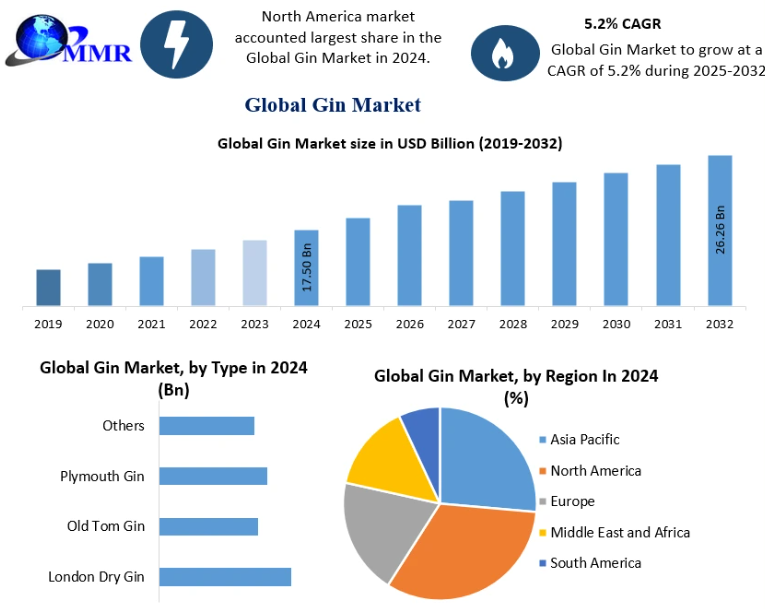Right Now
Gin Industry Innovation Report: New Flavors, Sustainable Practices, and Consumer Shifts
Market Estimation & Definition
The Gin Industry was valued at approximately USD 17.5 billion in 2024 and is projected to reach nearly USD 26.26 billion by 2032, growing at a CAGR of 5.2% during the forecast period. Gin is a distilled alcoholic beverage flavored predominantly with juniper berries and other botanicals. It encompasses various styles, including the malty-flavored Dutch genever and the drier forms like London Dry Gin, which are distinguished by different botanical flavorings.
Market Growth Drivers & Opportunities
Several factors are propelling the growth of the gin market:
Rising Demand for Alcoholic Beverages: The increasing consumption of alcoholic beverages in both developed and developing economies, coupled with a growing millennial population and rising disposable incomes, is driving the demand for gin.
Premiumization Trend: Consumers are shifting towards premium and super-premium gin categories, valuing quality over quantity. This trend is largely driven by millennials who are willing to spend more on quality products that offer unique experiences.
E-commerce Growth: The COVID-19 pandemic accelerated the shift towards online shopping, leading to increased e-commerce sales of gin. Consumers are increasingly using the internet to explore and purchase gin products, which has expanded the market reach.
Ask for Sample to Know US Tariff Impacts on Gin Industry @ https://www.maximizemarketresearch.com/request-sample/125491/
What Lies Ahead: Emerging Trends Shaping the Future
The gin market is witnessing several emerging trends:
Craft and Artisanal Gins: Small-scale producers are leveraging local botanicals and traditional distilling techniques to create unique gin variants that appeal to modern consumers seeking authenticity and quality.
Flavored and Low-Alcohol Gins: The introduction of flavored gins and the development of low-alcohol and non-alcoholic gin options cater to health-conscious consumers seeking variety and moderation.
Sustainability and Ethical Practices: Distilleries are adopting eco-friendly practices, such as using renewable energy, sustainable sourcing of botanicals, and recyclable packaging, to meet the growing demand for sustainable and ethically produced gins.
Gin Tourism and Experiential Marketing: The growing trend of experiential drinking presents a significant opportunity for the gin market. Consumers are increasingly seeking immersive experiences such as gin-tasting events, distillery tours, and cocktail masterclasses.
Segmentation Analysis
According to the Maximize Market Research report, the gin market is segmented as follows:
By Type: London Dry Gin, Old Tom Gin, Plymouth Gin, and others.
By Product Type: Flavored Gin and Non-Flavored Gin.
By Price Point: Standard, Premium, and Luxury.
By Distribution Channel: On-Trade (bars, restaurants) and Off-Trade (retail stores, online platforms).
By Region: North America, Europe, Asia Pacific, Middle East & Africa, and South America.
Curious about trends & forecasts: https://www.maximizemarketresearch.com/market-report/gin-market/125491/
Country-Level Analysis: USA and Germany
USA: The American gin market is witnessing a notable influx of Indian brands, each bringing unique flavors and stories to the table. Brands like Jaisalmer Classic Gin and Stranger & Sons Gin are expanding their presence in the U.S., catering to consumers' growing interest in diverse and premium gin offerings.
Germany: Germany remains a key contributor to the European gin market, with a strong tradition of gin production and consumption. The presence of numerous craft distilleries and a thriving cocktail culture continue to fuel market growth in the region.
Competitive Landscape
The gin market is characterized by a mix of established players and emerging craft distilleries. Key players include Diageo plc, Pernod Ricard, Bacardi Limited, William Grant & Sons, and Beam Suntory Inc. These companies are focusing on product innovation, strategic partnerships, and expanding their global footprint to maintain a competitive edge.
Emerging craft distilleries are differentiating themselves by offering unique, locally-inspired gin variants and engaging consumers through experiential marketing and storytelling. This dynamic landscape fosters innovation and caters to the evolving preferences of gin consumers worldwide.
Conclusion
The global gin market is poised for significant growth, driven by changing consumer preferences, premiumization trends, and the rise of craft and artisanal gins. As consumers seek unique experiences and high-quality products, gin producers are innovating to meet these demands. The expansion of e-commerce and experiential marketing further enhances market opportunities. With a diverse range of offerings and a dynamic competitive landscape, the gin market is set to flourish in the coming years, appealing to both traditional enthusiasts and new consumers alike.
About Us
More Posts
Report This Post
Please complete the following requested information to flag this post and report abuse, or offensive content. Your report will be reviewed within 24 hours. We will take appropriate action as described in Findit terms of use.














